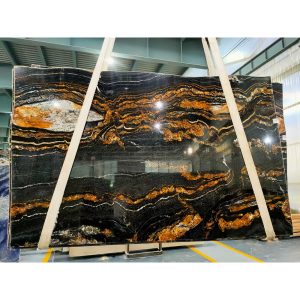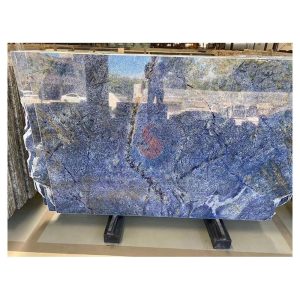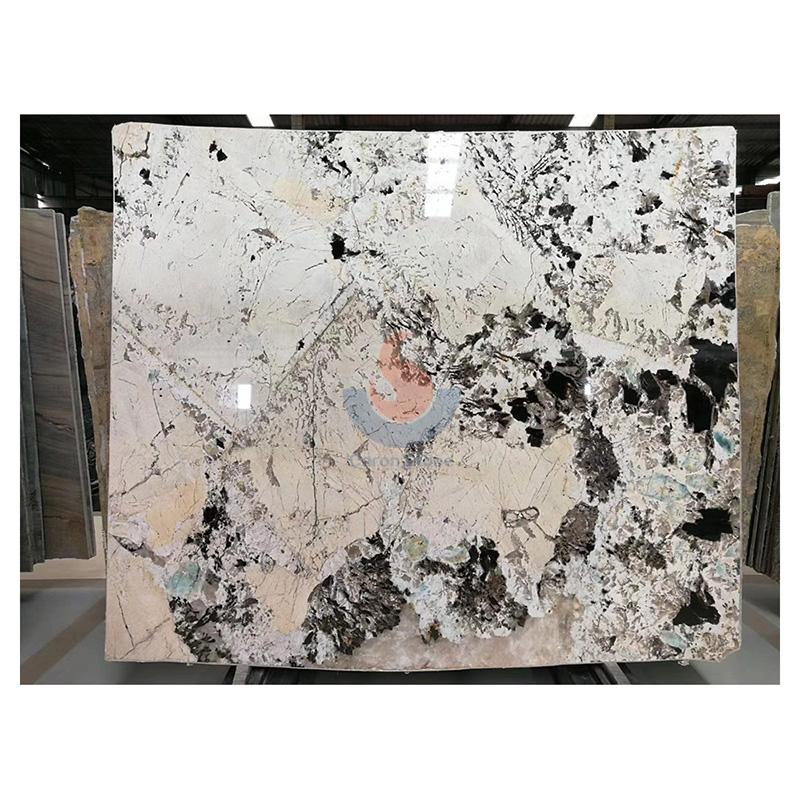Granite is favored in interior decoration and architectural design for its natural beauty, durability, and versatility. However, customizing granite is not an easy task and requires thoughtful choices on multiple levels by designers and owners. The design aspects that have to be taken into account while customizing granite will be discussed in this article to guarantee that the chosen material not only looks good but also satisfies the requirements of durability and utility.

Matrix Titanium Granite slab
In-depth consideration of color selection
Color not only affects the first impression of a space, but is also closely related to the emotional response of the occupants. While considering the effect of light on color and the function of color in generating the ambiance of the space, the color choice for customizing granite should be coordinated with the general tone and style of the interior. Warm-toned granite, for instance, can make a room more inviting; cool tones convey modernism and freshness.
Personalized selection of textures and patterns
Granite has its special appeal in terms of textures and patterns. They give the space inherent levels and depth. Choose a texture based on how it complements other components of the area and how you might guide visual flow or establish a focal point by varying texture. In addition, personalized pattern design can further enhance the personalization and artistry of the space.
Precise Matching of Size and Shape
The layout and efficiency of space depend directly on the size and shape chosen. Large-sized granite slabs are suitable for spacious spaces and can provide a continuous visual effect, while small-sized tiles or mosaics are suitable for areas with rich details, such as bathrooms or kitchen backsplashes. The final appearance and installation simplicity should also guide the form choice.
Functionality and Aesthetics of Surface Treatment
Surface treatment influences granite’s upkeep and durability as well as its appearance. Polished surfaces are smooth and easy to clean, suitable for high-traffic areas; matte surfaces are more wear-resistant and suitable for home environments. Granite’s unique texture and look from flame treatment fit modern and industrial style designs.
Detailed Attention to Edge Treatment
Part of detail design, edge treatment is not only associated with aesthetics but also with safety of use. Appropriate edge treatment can enhance the sophistication of the overall design, such as rounded or beveled edges can reduce the safety hazards caused by sharp edges, while straight edges provide a simple and modern appearance.
Installation Method’s Stability and Durability
Granite’s stability and durability are decided upon by the installation technique. Dry hanging installation is suitable for walls, which can reduce the stress of stone caused by temperature changes; while adhesive installation is more suitable for floors or countertops, providing good adhesion and stability.
Fine process of joint treatment
Joint treatment is the key to ensuring the overall beauty of granite. Appropriate joint width and color choice can improve the visual impact and prevent the use influenced by too large joints. Furthermore increasing the waterproof performance of stone and extending its service life is high-quality joint treatment.
Long-term considerations for maintenance and cleaning
Understanding the maintenance and cleaning requirements of granite is essential to maintaining its beauty. Selecting simple surface treatments and suitable cleaning agents will help the stone to last longer and save daily maintenance time and effort.
Reasonable planning of budget
Budget is a practical factor that must be considered when customizing granite. Reasonable budget planning and choosing cost-effective materials and designs can control costs without sacrificing quality. Budget planning often incorporates long-term maintenance expenditures at the same time.
Adaptability to environmental factors
Environmental factors, such as humidity and temperature changes, have a direct impact on the performance of granite. Selecting granite appropriate for particular environmental circumstances based on type and treatment guarantees its long-term stability and endurance.
Sustainable Choices
Choosing sustainably sourced granite is not only environmentally responsible, but also reflects the social responsibility of design. Sustainable granite sourcing lessens environmental impact by means of meeting environmental criteria for mining and processing of the stone.
Comprehensive Consideration of Functionality
Customizing granite mostly depends on functionality. Choose granite with matching properties, such heat resistance, scratch resistance or slip resistance, depending on the particular use needs of the space. These properties directly influence the material’s lifetime and fit.
Design coherence: harmony and unity
To attain a harmonic unity of the whole design, make sure the granite complements the style and material of other design components. This covers furniture, lighting, decorations, etc., so matching the granite’s tone, texture, and style.
Unique Expression of Personalized Elements
Consider including unique design features, such carvings or unusual forms cut to accentuate the uniqueness and personal expression of the area, when personalizing granite. These elements can become the highlight of the space and reflect the personality and taste of the occupants.

Natural Stone High Polished Blue Bahia Granite Quarzite
Customizing granite addresses aesthetics, utility, durability, and personalization in a whole. From color selection to texture, size, shape, surface treatment, installation method, joint treatment, maintenance and cleaning, every design element is crucial. Together with money, environmental issues, sustainability, practicality and design consistency, you may design a place that is both aesthetically pleasing and useful by weighing these components. Personalized design elements add unique personality and charm to the space. Custom granite is ultimately a search of quality of life and respect of details, not only a material decision.





